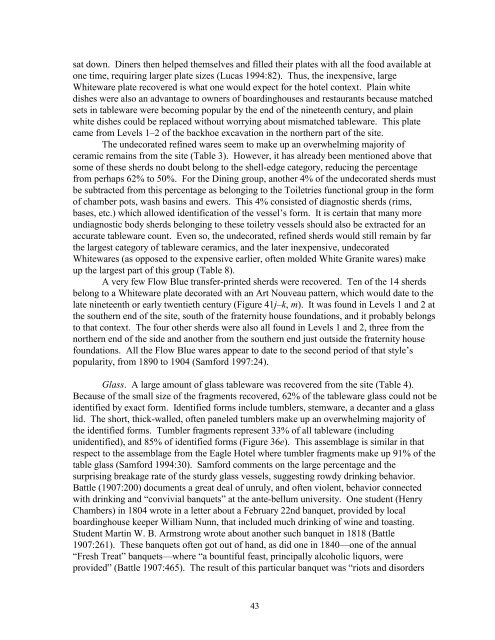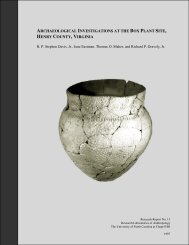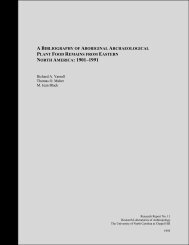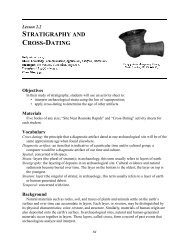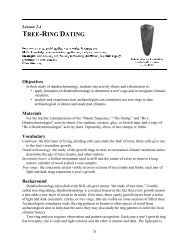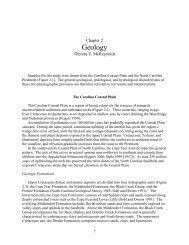(Majewski and O’Brien 1987:127), but the decorative treatments on the porcelain includehand-painting—over and underglaze, painted lustre, and polychrome transfer print. These aretreatments which would have been applied in the first half <strong>of</strong> the nineteenth century. No laterdecorative treatments such as overglaze decal motifs (post-1880) were recovered. Identifiedvessel forms for the Chinese export ware include a plate, lid, ginger jar form, and a saucer.Vessel forms identified for the European porcelain include cup, saucer, bowl and plate.Porcelain tea wares would have been among the most expensive ceramics available in thenineteenth century.The stratigraphic distribution indicates a mid-nineteenth-century date range for most<strong>of</strong> the porcelain, although some <strong>of</strong> it does pre-date the “Poor House,” being found beneaththat structure’s foundations (Table 11).Non-porcelain, hand-painted wares make up a little over 3% <strong>of</strong> the total ceramic sherdcount. Hand-painted decoration during the nineteenth century was most common onPearlwares (Majewski and O’Brien 1987:157), and this is true for the Lot 11 assemblage.The hand-painted wares were 3% Creamware, 57% Pearlware, 39% Whiteware, and 1%Lustreware (Table 3), indicating an early nineteenth-century context. Almost two-thirds <strong>of</strong>these were found in Level 4 (Table 11), which also indicates an early nineteenth-century timespan.The decorative techniques included hand-painting, stencil-painting, sponge-painting,stamped-painting, and sprig-painted styles (Figure 43c–d, h–i). Most <strong>of</strong> these were mostpopular between 1810 and 1860 (Majewski and O’Brien 1987:159). These styles were <strong>of</strong>tenapplied to tea wares (Majewski and O’Brien 1987:158), and identified vessel forms includetea cups and plates. The prices for these hand-painted wares fall between that <strong>of</strong> the transferprintedwares and the shell-edged wares (Majewski and O’Brien 1987:159).A minuscule amount <strong>of</strong> miscellaneous glazed wares was recovered from the site(Table 3), all in Levels 2 and 4. The vessel forms represented include an Astbury ware teapotspout, a blue-glazed Whiteware bowl, and a blue-glazed White Granite teacup. The waretypes are all Whiteware or White Granite, and two <strong>of</strong> the White granite sherds are salt-glazed.As expected from the ware types, no sherds were found in Level 4 underneath the foundation<strong>of</strong> the “Poor House” (Table 11).By the 1850s the undecorated White Granite tablewares had replaced shell-edged andtransfer-printed wares in popularity (see discussion <strong>of</strong> White Granite wares above, and Tables8 and 10). When introduced, White Granite was one <strong>of</strong> the more expensive tablewaresavailable, being equal to the prices <strong>of</strong> transfer-printed wares. The price decreased as thecentury progressed (Miller 1980:14). White Granite vessel forms recovered from the siteinclude a molded cup, plate, saucer, serving dishes, pitchers, and soup tureen (Figure 40a–b).Undecorated Whiteware forms succeeded White Granite in the 1880s. UndecoratedWhiteware forms recovered from the site include cups (molded and plain), saucer, bowl,plates (molded and plain), cream pitcher, and platter. The one reconstructed Whiteware platemeasures 9.5 inches in diameter (Figure 42). The plain style and size were common fordishes found in boarding house contexts. By the 1880s middle-class society was trying toemulate the wealthy by dining “a la Russe,” or serving dinner one course at a time. Ceramicmanufacturers in the 1880s and 1890s catered to this ideal by making smaller, eight-inchdinner plates in decorative ceramic sets (Lucas 1994:84). Boardinghouses without servants,still served dinner “Old English” style by placing all the food on the table before the diners42
sat down. Diners then helped themselves and filled their plates with all the food available atone time, requiring larger plate sizes (Lucas 1994:82). Thus, the inexpensive, largeWhiteware plate recovered is what one would expect for the hotel context. Plain whitedishes were also an advantage to owners <strong>of</strong> boardinghouses and restaurants because matchedsets in tableware were becoming popular by the end <strong>of</strong> the nineteenth century, and plainwhite dishes could be replaced without worrying about mismatched tableware. This platecame from Levels 1–2 <strong>of</strong> the backhoe excavation in the northern part <strong>of</strong> the site.The undecorated refined wares seem to make up an overwhelming majority <strong>of</strong>ceramic remains from the site (Table 3). However, it has already been mentioned above thatsome <strong>of</strong> these sherds no doubt belong to the shell-edge category, reducing the percentagefrom perhaps 62% to 50%. For the Dining group, another 4% <strong>of</strong> the undecorated sherds mustbe subtracted from this percentage as belonging to the Toiletries functional group in the form<strong>of</strong> chamber pots, wash basins and ewers. This 4% consisted <strong>of</strong> diagnostic sherds (rims,bases, etc.) which allowed identification <strong>of</strong> the vessel’s form. It is certain that many moreundiagnostic body sherds belonging to these toiletry vessels should also be extracted for anaccurate tableware count. Even so, the undecorated, refined sherds would still remain by farthe largest category <strong>of</strong> tableware ceramics, and the later inexpensive, undecoratedWhitewares (as opposed to the expensive earlier, <strong>of</strong>ten molded White Granite wares) makeup the largest part <strong>of</strong> this group (Table 8).A very few Flow Blue transfer-printed sherds were recovered. Ten <strong>of</strong> the 14 sherdsbelong to a Whiteware plate decorated with an Art Nouveau pattern, which would date to thelate nineteenth or early twentieth century (Figure 41j–k, m). It was found in Levels 1 and 2 atthe southern end <strong>of</strong> the site, south <strong>of</strong> the fraternity house foundations, and it probably belongsto that context. The four other sherds were also all found in Levels 1 and 2, three from thenorthern end <strong>of</strong> the side and another from the southern end just outside the fraternity housefoundations. All the Flow Blue wares appear to date to the second period <strong>of</strong> that style’spopularity, from 1890 to 1904 (Samford 1997:24).Glass. A large amount <strong>of</strong> glass tableware was recovered from the site (Table 4).Because <strong>of</strong> the small size <strong>of</strong> the fragments recovered, 62% <strong>of</strong> the tableware glass could not beidentified by exact form. Identified forms include tumblers, stemware, a decanter and a glasslid. The short, thick-walled, <strong>of</strong>ten paneled tumblers make up an overwhelming majority <strong>of</strong>the identified forms. Tumbler fragments represent 33% <strong>of</strong> all tableware (includingunidentified), and 85% <strong>of</strong> identified forms (Figure 36e). This assemblage is similar in thatrespect to the assemblage from the Eagle Hotel where tumbler fragments make up 91% <strong>of</strong> thetable glass (Samford 1994:30). Samford comments on the large percentage and thesurprising breakage rate <strong>of</strong> the sturdy glass vessels, suggesting rowdy drinking behavior.Battle (1907:200) documents a great deal <strong>of</strong> unruly, and <strong>of</strong>ten violent, behavior connectedwith drinking and “convivial banquets” at the ante-bellum university. One student (HenryChambers) in 1804 wrote in a letter about a February 22nd banquet, provided by localboardinghouse keeper William Nunn, that included much drinking <strong>of</strong> wine and toasting.Student Martin W. B. Armstrong wrote about another such banquet in 1818 (Battle1907:261). These banquets <strong>of</strong>ten got out <strong>of</strong> hand, as did one in 1840—one <strong>of</strong> the annual“Fresh Treat” banquets—where “a bountiful feast, principally alcoholic liquors, wereprovided” (Battle 1907:465). The result <strong>of</strong> this particular banquet was “riots and disorders43
- Page 1 and 2:
ARCHAEOLOGICAL INVESTIGATIONS AT TH
- Page 3 and 4: ABSTRACTArchaeological investigatio
- Page 5 and 6: Moffitt, Brooks Rainey, Patricia Sa
- Page 7 and 8: ChapterPage6. Conclusions and Recom
- Page 9 and 10: TablePage16. Distribution of cerami
- Page 11 and 12: FigurePage18. Excavating Sq. 140R95
- Page 13 and 14: Chapter 1INTRODUCTIONThis report de
- Page 15 and 16: Chapter 2HISTORICAL BACKGROUNDThe t
- Page 17 and 18: Book 17:59-60). Gavin Hogg paid off
- Page 19 and 20: and the sale of the western half of
- Page 21 and 22: After the Civil War, the town fell
- Page 23 and 24: train young men and women to teach
- Page 25 and 26: the university was the Delta Kappa
- Page 27 and 28: ENDNOTES1 A typescript of this deed
- Page 29 and 30: Chapter 3FIELD METHODSFieldwork was
- Page 31 and 32: Chapter 4RESULTS OF ARCHAEOLOGICAL
- Page 33 and 34: foundations were 2 ft wide and the
- Page 35 and 36: Level 2aThis soil level occurred on
- Page 37 and 38: Feature 2Feature 2 was a linear dis
- Page 39 and 40: Feature 12Feature 12 was a small, s
- Page 41 and 42: ARCHITECTURAL GROUPA large number o
- Page 43 and 44: southern and northern parts of the
- Page 45 and 46: Kitchen GroupCeramics. As shown in
- Page 47 and 48: is probably no earlier than the sec
- Page 49: consumption of wine in ante-bellum
- Page 53: 50% of the assemblage). If, and whe
- Page 57 and 58: ecords show his property increased
- Page 59 and 60: The ceramic marbles could easily be
- Page 61 and 62: southern to northern halves of the
- Page 63 and 64: anthropomorphic pipes (Sudbury 1979
- Page 65 and 66: TOILETRIES GROUPThe Toiletries grou
- Page 67 and 68: shampoo bottles, and a cosmetic jar
- Page 69 and 70: Items likely associated with the fr
- Page 71 and 72: Chapter 6CONCLUSIONS AND RECOMMENDA
- Page 73 and 74: REFERENCESAnonymousc.1797 Plan of t
- Page 75 and 76: Majewski, Teresita, and Michael J.
- Page 77 and 78: Wilson, Louis R.1957 The University
- Page 79 and 80: Table 1 continued.Activity Group Qu
- Page 81 and 82: Table 3 continued.Category 0-2 cm 2
- Page 83 and 84: Table 7. Distribution of kitchen ce
- Page 85 and 86: Table 10. Distribution of ceramic t
- Page 87 and 88: Table 13. Distribution of glass and
- Page 89 and 90: Table 17. Distribution of pharmaceu
- Page 91 and 92: PRESBYTERIANCHURCHHENDERSON STREETN
- Page 93 and 94: Figure 4. 1797 map of Chapel Hill a
- Page 95 and 96: Figure 6. 1857 Chapel Hill Business
- Page 97 and 98: Figure 8. View of Franklin Street l
- Page 99 and 100: Figure 10. Portion of a 1911 map co
- Page 101 and 102: Figure 12. Delta Kappa Epsilon hous
- Page 103 and 104: Figure 14. Kemp P. Battle with Phi
- Page 105 and 106:
Figure 16. Portion of a 1932 map co
- Page 107 and 108:
Figure 18. Excavating Sq. 140R95 pr
- Page 109 and 110:
Figure 20. Removing topsoil from th
- Page 111 and 112:
Figure 22. Exposing the south wall
- Page 113 and 114:
Pettigrew Site(RLA-Or412)Architectu
- Page 115 and 116:
Stone FoundationsStone FoundationsD
- Page 117 and 118:
Figure 28. View of Structure 2 full
- Page 119 and 120:
160 150 140 130 120 110 100100 ft99
- Page 121 and 122:
Figure 32. Prehistoric lithic artif
- Page 123 and 124:
Figure 34. Miscellaneous ceramic an
- Page 125 and 126:
Figure 36. Glassware: oil lamp chim
- Page 127 and 128:
Figure 38. Stoneware: Virginia-made
- Page 129 and 130:
Figure 40. Refined, undecorated war
- Page 131 and 132:
Figure 42. Whiteware plate, 9.5”
- Page 133 and 134:
Figure 44. Transfer printed wares:
- Page 135 and 136:
Figure 46. Transfer printed wares:
- Page 137 and 138:
Figure 48. Toothbrushes and possibl
- Page 139 and 140:
Figure 50. Early to mid-nineteenth-
- Page 141 and 142:
Figure 52. Refined, undecorated whi
- Page 143 and 144:
Figure 54. Glass cosmetic and shamp
- Page 145 and 146:
Appendix 1. Chain of title for Lot
- Page 147 and 148:
30030024060300Lot 11George Johnston


